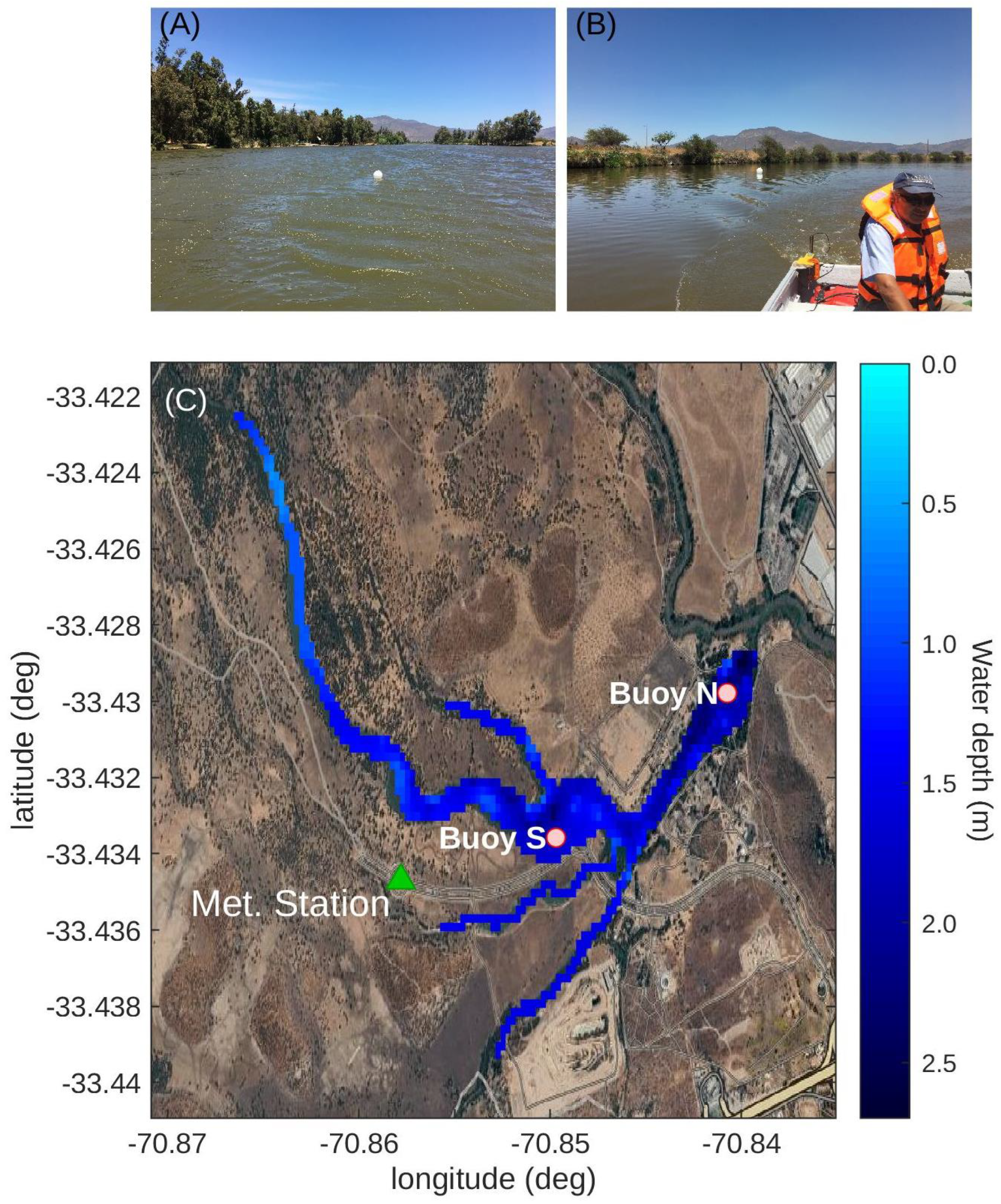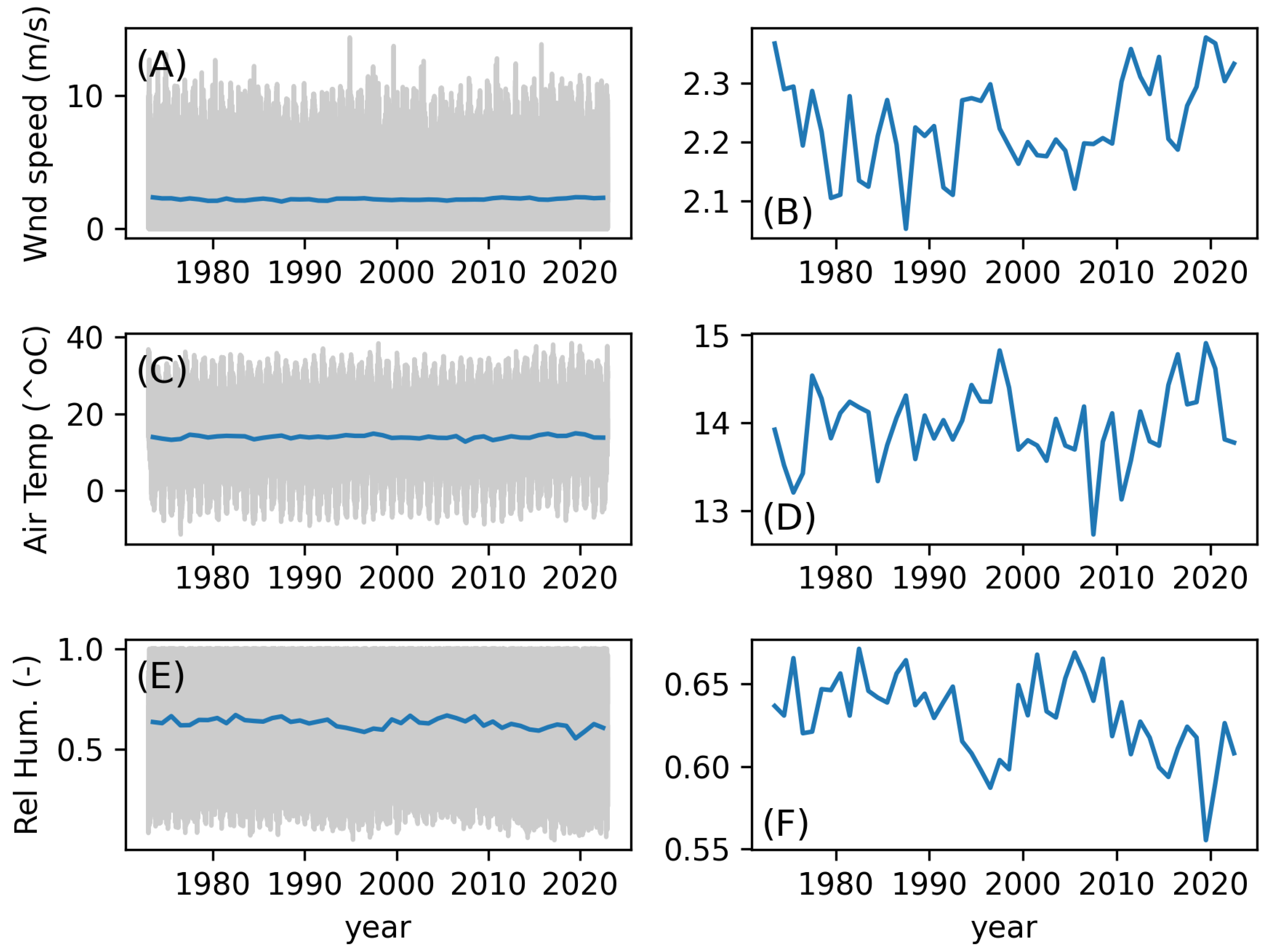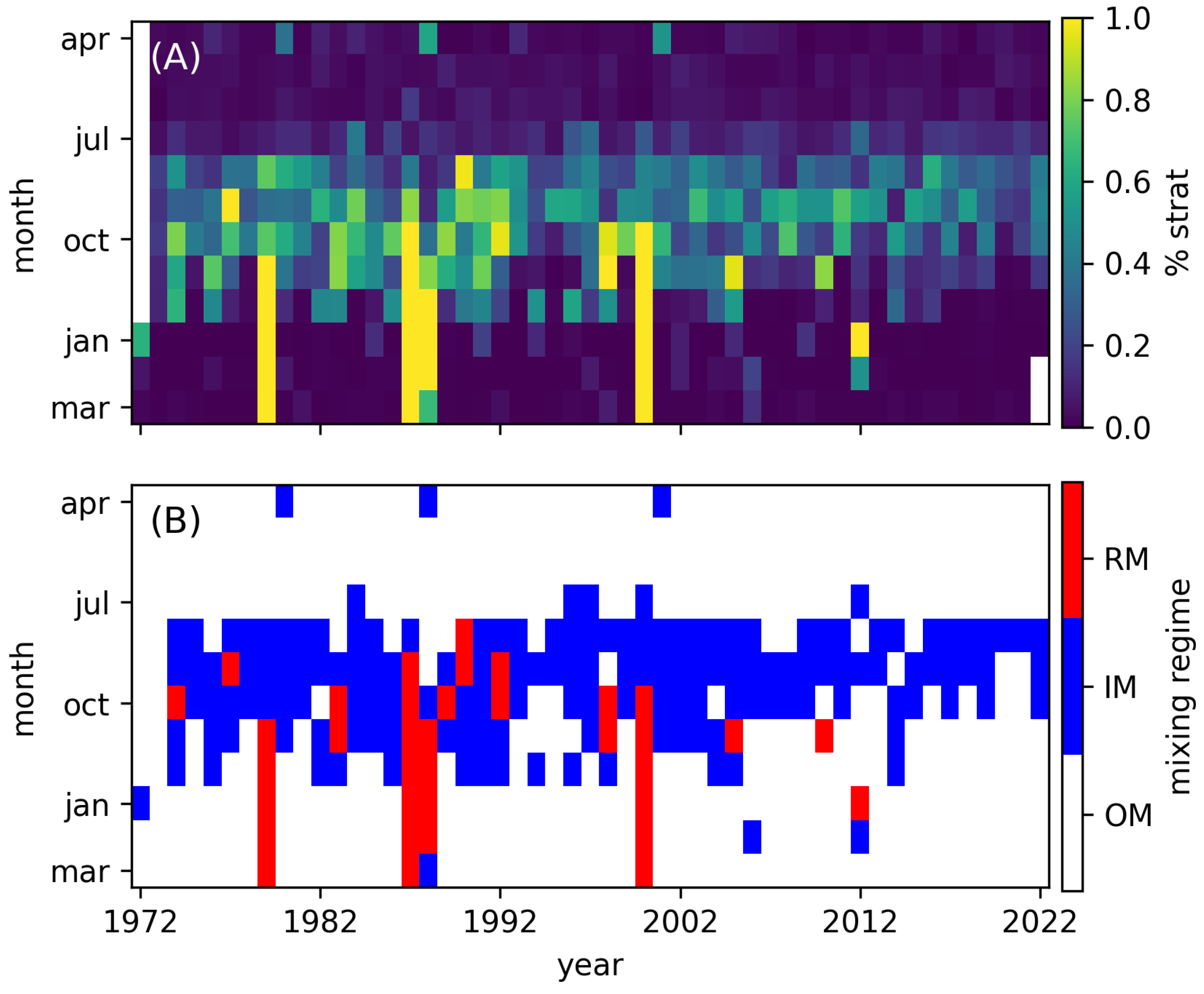Mixing Regimes in a Shallow Lake over the Past Five Decades: Application to Laguna Carén
Abstract
1. Introduction
2. Methods
2.1. Study Site and Field Observations
2.2. Numerical Model
2.3. Meteorological Forcing
2.4. Calibration of the Hydrodynamics Model
- Wind drag coefficient (). This parameter determines the available turbulent kinetic energy for vertical mixing. The AEM3D model computes as a function of the atmospheric boundary layer stability, and it allows to specify the maximum value of , which is considered constant and homogeneous over the lake surface and defines the surface roughness of the lake. For small lakes where the atmospheric boundary layer is not fully developed, values are typically smaller than 1.3 × .
2.5. Classification of the Mixing Regime
3. Results
3.1. Calibration and Validation
3.2. Annual Classification of Mixing Regimes
3.3. Influence of Meteorological Forcings on the Mixing Regime
3.4. Monthly Classifying of Mixing Regimes
4. Discussion
4.1. Hydrodynamics Simulation of Shallow Lakes
4.2. Wind Speed
4.3. Spatial Differences in the Mixing Regime
4.4. Climate Change Simulations
5. Conclusions
Author Contributions
Funding
Data Availability Statement
Conflicts of Interest
References
- Cole, J.J.; Prairie, Y.T.; Caraco, N.F.; McDowell, W.H.; Tranvik, L.J.; Striegl, R.G.; Duarte, C.M.; Kortelainen, P.; Downing, J.A.; Middelburg, J.J.; et al. Plumbing the global carbon cycle: Integrating inland waters into the terrestrial carbon budget. Ecosystems 2007, 10, 171–184. [Google Scholar] [CrossRef]
- Tranvik, L.J.; Downing, J.A.; Cotner, J.B.; Loiselle, S.A.; Striegl, R.G.; Ballatore, T.J.; Dillon, P.; Finlay, K.; Fortino, K.; Knoll, L.B.; et al. Lakes and reservoirs as regulators of carbon cycling and climate. Limnol. Oceanogr. 2009, 54, 2298–2314. [Google Scholar] [CrossRef]
- Strassburg, B.B.; Iribarrem, A.; Beyer, H.L.; Cordeiro, C.L.; Crouzeilles, R.; Jakovac, C.C.; Junqueira, A.B.; Lacerda, E.; Latawiec, A.E.; Balmford, A.; et al. Global priority areas for ecosystem restoration. Nature 2020, 586, 724–729. [Google Scholar] [CrossRef]
- Holgerson, M.A.; Richardson, D.C.; Roith, J.; Bortolotti, L.E.; Finlay, K.; Hornbach, D.J.; Gurung, K.; Ness, A.; Andersen, M.R.; Bansal, S.; et al. Classifying Mixing Regimes in Ponds and Shallow Lakes. Water Resour. Res. 2022, 58, e2022WR032522. [Google Scholar] [CrossRef]
- Davidson, T.A.; Søndergaard, M.; Audet, J.; Levi, E.; Esposito, C.; Bucak, T.; Nielsen, A. Temporary stratification promotes large greenhouse gas emissions in a shallow eutrophic lake. Biogeosciences 2024, 21, 93–107. [Google Scholar] [CrossRef]
- Masunaga, E.; Komuro, S. Stratification and mixing processes associated with hypoxia in a shallow lake (Lake Kasumigaura, Japan). Limnology 2020, 21, 173–186. [Google Scholar] [CrossRef]
- Adrian, R.; O’Reilly, C.M.; Zagarese, H.; Baines, S.B.; Hessen, D.O.; Keller, W.; Livingstone, D.M.; Sommaruga, R.; Straile, D.; Donk, E.V.; et al. Lakes as sentinels of climate change. Limnol. Oceanogr. 2009, 54, 2283–2297. [Google Scholar] [CrossRef] [PubMed]
- Williamson, C.E.; Saros, J.E.; Vincent, W.F.; Smol, J.P. Lakes and reservoirs as sentinels, integrators, and regulators of climate change. Limnol. Oceanogr. 2009, 54, 2273–2282. [Google Scholar] [CrossRef]
- Bouffard, D.; Wüest, A. Convection in Lakes. Annu. Rev. Fluid Mech. 2019, 51, 189–215. [Google Scholar] [CrossRef]
- Fischer, H.; List, R.; Imberger, J.; Brooks, N. Mixing in Island and Coastal Waters; Academic Press: Cambridge, MA, USA, 1979. [Google Scholar]
- Imberger, J. Environmental Fluid Dynamics; Academic Press: Cambridge, MA, USA, 2013. [Google Scholar] [CrossRef]
- Wüest, A.; Lorke, A. Small-Scale Hydrodynamics in Lakes. Annu. Rev. Fluid Mech. 2003, 35, 373–412. [Google Scholar]
- Hodges, B.R.; Imberger, J.; Saggio, A.; Winters, K.B. Modeling basin-scale internal waves in a stratified lake. Limnol. Oceanogr. 2000, 45, 1603–1620. [Google Scholar] [CrossRef]
- Ivey, G.N.; Winters, K.B.; Koseff, J.R. Density stratification, turbulence, but how much mixing? Annu. Rev. Fluid Mech. 2008, 40, 169–184. [Google Scholar]
- Winters, K.B.; Lombard, P.N.; Riley, J.J.; D’Asaro, E.A. Available potential energy and mixing in density-stratified fluids. J. Fluid Mech. 1995, 289, 115. [Google Scholar] [CrossRef]
- Ulloa, H.N.; Wüest, A.; Bouffard, D. Mechanical energy budget and mixing efficiency for a radiatively heated ice-covered waterbody. J. Fluid Mech. 2018, 852, R1–R13. [Google Scholar] [CrossRef]
- Fang, X.; Stefan, H.G. Dynamics of heat exchange between sediment and water in a lake. Water Resour. Res. 1996, 32, 1719–1727. [Google Scholar] [CrossRef]
- Fang, X.; Stefan, H.G. Temperature Variability in Lake Sediments. Water Resour. Res. 1998, 34, 717–729. [Google Scholar]
- Csanady, G.; Lumley, J. Air-Sea Interaction: Laws and Mechanisms. Appl. Mech. Rev. 2002, 55, 1508156. [Google Scholar] [CrossRef]
- Garratt, J.R. The Atmospheric Boundary Layer; Cambridge University Press: Cambridge, UK, 1992. [Google Scholar]
- de la Fuente, A.; Meruane, C. Spectral model for long-term computation of thermodynamics and potential evaporation in shallow wetlands. Water Resour. Res. 2017, 53, 7696–7715. [Google Scholar] [CrossRef]
- Woolway, R.I.; Sharma, S.; Weyhenmeyer, G.A.; Debolskiy, A.; Golub, M.; Mercado-Bettín, D.; Perroud, M.; Stepanenko, V.; Tan, Z.; Grant, L.; et al. Phenological shifts in lake stratification under climate change. Nat. Commun. 2021, 12, 19. [Google Scholar] [CrossRef]
- Piccioni, F.; Casenave, C.; Lemaire, B.J.; Moigne, P.L.; Dubois, P.; Vinçon-Leite, B. The thermal response of small and shallow lakes to climate change: New insights from 3D hindcast modelling. Earth Syst. Dyn. 2021, 12, 439–456. [Google Scholar] [CrossRef]
- de la Fuente, A.; Meruane, C. Dimensionless numbers for classifying the thermodynamics regimes that determine water temperature in shallow lakes and wetlands. Environ. Fluid Mech. 2017, 17, 1081–1098. [Google Scholar] [CrossRef]
- Martinsen, K.T.; Andersen, M.R.; Sand-Jensen, K. Water temperature dynamics and the prevalence of daytime stratification in small temperate shallow lakes. Hydrobiologia 2019, 826, 247–262. [Google Scholar] [CrossRef]
- Aranguiz, C. Estudio e Identificación de los Procesos bioquíMicos Asociados a los Nutrientes N y P en Interacción con el ciclo del Carbono. Caso de Estudio: Laguna Carén, Chile. Undergraduate Thesis, Universidad de Chile, Santiago, Chile, 2019. Available online: https://repositorio.uchile.cl/handle/2250/171000 (accessed on 27 March 2024). (In Spanish).
- Sáez, B.; Boegman, L.; Olshoorn, J.; de la Fuente, A. A model of stratification and mixing in a shallow lake with heat flux at the sediment-water interface: Application to Laguna Carén. J. Geophys. Res. 2025, submit. [Google Scholar]
- Hersbach, H.; Bell, B.; Berrisford, P.; Hirahara, S.; Horányi, A.; Muñoz-Sabater, J.; Nicolas, J.; Peubey, C.; Radu, R.; Schepers, D.; et al. The ERA5 global reanalysis. Q. J. R. Meteorol. Soc. 2020, 146, 1999–2049. [Google Scholar] [CrossRef]
- Markfort, C.D.; Porté-Agel, F.; Stefan, H.G. Canopy-wake dynamics and wind sheltering effects on Earth surface fluxes. Environ. Fluid Mech. 2014, 14, 663–697. [Google Scholar] [CrossRef]
- Hodges, B.; Dallimore, C. Estuary, Lake and Coastal Ocean Model: ELCOM v2. 2 User Manual; Centre for Water Research, The University of Western Australia: Crawley, Australia, 2010. [Google Scholar]
- Maraun, D.; Wetterhall, F.; Ireson, A.M.; Chandler, R.E.; Kendon, E.J.; Widmann, M.; Brienen, S.; Rust, H.W.; Sauter, T.; Themel, M.; et al. Precipitation downscaling under climate change: Recent developments to bridge the gap between dynamical models and the end user. Rev. Geophys. 2010, 48, 2009RG000314. [Google Scholar] [CrossRef]
- Du, J.; Jacinthe, P.A.; Song, K.; Zhou, H. Water surface albedo and its driving factors on the turbid lakes of Northeast China. Ecol. Indic. 2023, 146, 109905. [Google Scholar] [CrossRef]
- Du, J.; Zhou, H.; Jacinthe, P.A.; Song, K. Retrieval of lake water surface albedo from Sentinel-2 remote sensing imagery. J. Hydrol. 2023, 617, 128904. [Google Scholar] [CrossRef]
- Gupta, H.V.; Kling, H.; Yilmaz, K.K.; Martinez, G.F. Decomposition of the mean squared error and NSE performance criteria: Implications for improving hydrological modelling. J. Hydrol. 2009, 377, 80–91. [Google Scholar] [CrossRef]
- Zhou, W.; Melack, J.M.; MacIntyre, S.; Barbosa, P.M.; Amaral, J.H.; Cortés, A. Hydrodynamic Modeling of Stratification and Mixing in a Shallow, Tropical Floodplain Lake. Water Resour. Res. 2024, 60, e2022WR034057. [Google Scholar] [CrossRef]
- Wüest, A.; Piepke, G.; Senden, D.V. Turbulent kinetic energy balance as a tool for estimating vertical diffusivity in wind-forced stratified waters. Limnol. Oceanogr. 2000, 45, 1388–1400. [Google Scholar] [CrossRef]
- Devlin, M.J.; Barry, J.; Mills, D.K.; Gowen, R.J.; Foden, J.; Sivyer, D.; Greenwood, N.; Pearce, D.; Tett, P. Estimating the diffuse attenuation coefficient from optically active constituents in UK marine waters. Estuarine, Coast. Shelf Sci. 2009, 82, 73–83. [Google Scholar] [CrossRef]
- Mitsch, W.J.; Gosselink, J.G. Wetlands, 5th ed.; John Wiley & Sons: Hoboken, NJ, USA, 2015; Volume 91. [Google Scholar]
- Wetzel, R.G. Limnology: Lake and River Ecosystems; Academic Press: Cambridge, MA, USA, 2001; p. 1006. [Google Scholar]
- Lagos-Zúñiga, M.; Mendoza, P.A.; Campos, D.; Rondanelli, R. Trends in seasonal precipitation extremes and associated temperatures along continental Chile. Clim. Dyn. 2024, 62, 4205–4222. [Google Scholar] [CrossRef]
- González-Reyes, A.; Jacques-Coper, M.; Bravo, C.; Rojas, M.; Garreaud, R. Evolution of heatwaves in Chile since 1980. Weather Clim. Extrem. 2023, 41, 100588. [Google Scholar] [CrossRef]
- Feron, S.; Cordero, R.R.; Damiani, A.; Oyola, P.; Ansari, T.; Pedemonte, J.C.; Wang, C.; Ouyang, Z.; Gallo, V. Compound climate-pollution extremes in Santiago de Chile. Sci. Rep. 2023, 13, 6726. [Google Scholar] [CrossRef]
- Stull, R.B. An Introduction to Boundary Layer Meteorology; Springer Dordrecht: Dordrecht, The Netherlands, 1988; Volume 13, p. 666. [Google Scholar]
- Monin, A.S.; Obukhov, A.M. Basic laws of turbulent mixing in the atmosphere near the ground. Tr. Akad. Nauk SSSR Geofiz. Inst 1954, 24, 163r187. [Google Scholar]
- Imberger, J. The diurnal mixed layer. Limnol. Oceanogr. 1985, 30, 737–770. [Google Scholar] [CrossRef]
- Eyring, V.; Bony, S.; Meehl, G.A.; Senior, C.A.; Stevens, B.; Stouffer, R.J.; Taylor, K.E. Overview of the Coupled Model Intercomparison Project Phase 6 (CMIP6) experimental design and organization. Geosci. Model Dev. 2016, 9, 1937–1958. [Google Scholar] [CrossRef]
- Cannon, A.J. Multivariate quantile mapping bias correction: An N-dimensional probability density function transform for climate model simulations of multiple variables. Clim. Dyn. 2018, 50, 31–49. [Google Scholar] [CrossRef]
- Piccolroaz, S.; Zhu, S.; Ladwig, R.; Carrea, L.; Oliver, S.; Piotrowski, A.P.; Ptak, M.; Shinohara, R.; Sojka, M.; Woolway, R.I.; et al. Lake Water Temperature Modeling in an Era of Climate Change: Data Sources, Models, and Future Prospects. Rev. Geophys. 2024, 62, e2023RG000816. [Google Scholar] [CrossRef]
- de la Fuente, A.; Meruane, C.; Meruane, V. Expected reliability over a planning horizon of a hydraulic infrastructure and its uncertainty under hydroclimatic future projections. J. Hydrol. 2023, 622, 129700. [Google Scholar] [CrossRef]












| Variable | Agregation | Percentile | coef | |
|---|---|---|---|---|
| (%) | (-) | (-) | ||
| Wnd.speed | max | 25 | 0.17 | −0.23 |
| Wnd.speed | min | 21 | 0.14 | −2.13 |
| Wnd.speed | avg | 21 | 0.21 | −0.60 |
| max | 48 | <0.01 | 0.00 | |
| min | 53 | 0.02 | 0.05 | |
| avg | 55 | 0.01 | 0.03 | |
| max | 53 | <0.01 | 0.12 | |
| min | 47 | <0.01 | −0.16 | |
| avg | 56 | <0.01 | −0.02 | |
| max | 72 | 0.12 | 2.00 | |
| min | 70 | 0.13 | 1.62 | |
| avg | 73 | 0.14 | 1.68 |
Disclaimer/Publisher’s Note: The statements, opinions and data contained in all publications are solely those of the individual author(s) and contributor(s) and not of MDPI and/or the editor(s). MDPI and/or the editor(s) disclaim responsibility for any injury to people or property resulting from any ideas, methods, instructions or products referred to in the content. |
© 2025 by the authors. Licensee MDPI, Basel, Switzerland. This article is an open access article distributed under the terms and conditions of the Creative Commons Attribution (CC BY) license (https://creativecommons.org/licenses/by/4.0/).
Share and Cite
Godoy, L.; Sáez, B.; de la Fuente, A. Mixing Regimes in a Shallow Lake over the Past Five Decades: Application to Laguna Carén. Water 2025, 17, 1007. https://doi.org/10.3390/w17071007
Godoy L, Sáez B, de la Fuente A. Mixing Regimes in a Shallow Lake over the Past Five Decades: Application to Laguna Carén. Water. 2025; 17(7):1007. https://doi.org/10.3390/w17071007
Chicago/Turabian StyleGodoy, Lucas, Bastián Sáez, and Alberto de la Fuente. 2025. "Mixing Regimes in a Shallow Lake over the Past Five Decades: Application to Laguna Carén" Water 17, no. 7: 1007. https://doi.org/10.3390/w17071007
APA StyleGodoy, L., Sáez, B., & de la Fuente, A. (2025). Mixing Regimes in a Shallow Lake over the Past Five Decades: Application to Laguna Carén. Water, 17(7), 1007. https://doi.org/10.3390/w17071007






